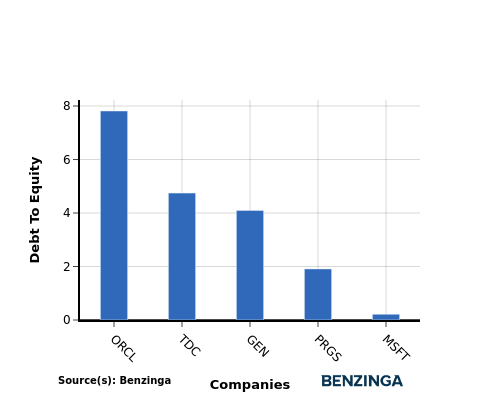
In today’s rapidly changing and highly competitive business world, it is imperative for investors and industry observers to carefully assess companies before making investment choices. In this article, we will undertake a comprehensive industry comparison, evaluating Microsoft MSFT vis-à-vis its key competitors in the Software industry. Through a detailed analysis of important financial indicators, market standing, and growth potential, our goal is to provide valuable insights and highlight company’s performance in the industry.
Microsoft Background
Microsoft develops and licenses consumer and enterprise software. It is known for its Windows operating systems and Office productivity suite. The company is organized into three equally sized broad segments: productivity and business processes (legacy Microsoft Office, cloud-based Office 365, Exchange, SharePoint, Skype, LinkedIn, Dynamics), intelligence cloud (infrastructure- and platform-as-a-service offerings Azure, Windows Server OS, SQL Server), and more personal computing (Windows Client, Xbox, Bing search, display advertising, and Surface laptops, tablets, and desktops).
| Company | P/E | P/B | P/S | ROE | EBITDA (in billions) | Gross Profit (in billions) | Revenue Growth |
|---|---|---|---|---|---|---|---|
| Microsoft Corp | 35.34 | 11.06 | 12.58 | 8.87% | $38.23 | $45.49 | 16.04% |
| Oracle Corp | 49.06 | 48.77 | 10.01 | 30.01% | $5.44 | $9.4 | 6.86% |
| ServiceNow Inc | 166.68 | 23.76 | 21.24 | 4.81% | $0.67 | $2.21 | 22.25% |
| Palo Alto Networks Inc | 51.41 | 22 | 16.99 | 6.33% | $0.45 | $1.58 | 13.88% |
| CrowdStrike Holdings Inc | 714.31 | 29.20 | 24.35 | -0.57% | $0.12 | $0.73 | 4.8% |
| Fortinet Inc | 48.46 | 81.40 | 13.02 | 90.26% | $0.66 | $1.24 | 13.0% |
| Gen Digital Inc | 31.21 | 9.08 | 5.06 | 7.92% | $0.51 | $0.78 | 3.07% |
| Monday.Com Ltd | 681.40 | 15.04 | 16.61 | -1.28% | $-0.02 | $0.23 | 32.67% |
| CommVault Systems Inc | 45.08 | 27.96 | 8.93 | 5.56% | $0.02 | $0.19 | 16.06% |
| Dolby Laboratories Inc | 29.86 | 3.09 | 6.14 | 2.39% | $0.07 | $0.27 | 4.9% |
| QXO Inc | 31.56 | 1.62 | 28.76 | -0.21% | $-0.03 | $0.01 | -2.0% |
| Qualys Inc | 34.42 | 12.69 | 9.87 | 10.53% | $0.05 | $0.13 | 8.36% |
| Teradata Corp | 36.79 | 23.94 | 1.72 | 32.0% | $0.08 | $0.27 | 0.46% |
| Progress Software Corp | 37.44 | 7.02 | 4.32 | 6.88% | $0.06 | $0.15 | 2.11% |
| SolarWinds Corp | 60.55 | 1.67 | 2.91 | 0.94% | $0.07 | $0.18 | 5.5% |
| Average | 144.16 | 21.95 | 12.14 | 13.97% | $0.58 | $1.24 | 9.42% |
Through a thorough examination of Microsoft, we can discern the following trends:
-
At 35.34, the stock’s Price to Earnings ratio is 0.25x less than the industry average, suggesting favorable growth potential.
-
The current Price to Book ratio of 11.06, which is 0.5x the industry average, is substantially lower than the industry average, indicating potential undervaluation.
-
The stock’s relatively high Price to Sales ratio of 12.58, surpassing the industry average by 1.04x, may indicate an aspect of overvaluation in terms of sales performance.
-
The Return on Equity (ROE) of 8.87% is 5.1% below the industry average, suggesting potential inefficiency in utilizing equity to generate profits.
-
The Earnings Before Interest, Taxes, Depreciation, and Amortization (EBITDA) of $38.23 Billion is 65.91x above the industry average, highlighting stronger profitability and robust cash flow generation.
-
Compared to its industry, the company has higher gross profit of $45.49 Billion, which indicates 36.69x above the industry average, indicating stronger profitability and higher earnings from its core operations.
-
The company’s revenue growth of 16.04% is notably higher compared to the industry average of 9.42%, showcasing exceptional sales performance and strong demand for its products or services.
Debt To Equity Ratio

The debt-to-equity (D/E) ratio is an important measure to assess the financial structure and risk profile of a company.
Considering the debt-to-equity ratio in industry comparisons allows for a concise evaluation of a company’s financial health and risk profile, aiding in informed decision-making.
By evaluating Microsoft against its top 4 peers in terms of the Debt-to-Equity ratio, the following observations arise:
-
Microsoft demonstrates a stronger financial position compared to its top 4 peers in the sector.
-
With a lower debt-to-equity ratio of 0.21, the company relies less on debt financing and maintains a healthier balance between debt and equity, which can be viewed positively by investors.
Key Takeaways
For Microsoft in the Software industry, the PE and PB ratios suggest that the stock is undervalued compared to its peers. However, the high PS ratio indicates that the market values its sales more highly. In terms of ROE, Microsoft’s performance is weaker than its peers, while its high EBITDA and gross profit margins indicate strong operational efficiency. Additionally, the high revenue growth suggests potential for future expansion and market dominance.
This article was generated by Benzinga’s automated content engine and reviewed by an editor.
Market News and Data brought to you by Benzinga APIs
© 2024 Benzinga.com. Benzinga does not provide investment advice. All rights reserved.

